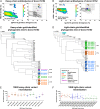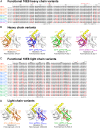Mining the antibodyome for HIV-1-neutralizing antibodies with next-generation sequencing and phylogenetic pairing of heavy/light chains
- PMID: 23536288
- PMCID: PMC3631616
- DOI: 10.1073/pnas.1219320110
Mining the antibodyome for HIV-1-neutralizing antibodies with next-generation sequencing and phylogenetic pairing of heavy/light chains
Abstract
Next-generation sequencing of antibody transcripts from HIV-1-infected individuals with broadly neutralizing antibodies could provide an efficient means for identifying somatic variants and characterizing their lineages. Here, we used 454 pyrosequencing and identity/divergence grid sampling to analyze heavy- and light-chain sequences from donor N152, the source of the broadly neutralizing antibody 10E8. We identified variants with up to 28% difference in amino acid sequence. Heavy- and light-chain phylogenetic trees of identified 10E8 variants displayed similar architectures, and 10E8 variants reconstituted from matched and unmatched phylogenetic branches displayed significantly lower autoreactivity when matched. To test the generality of phylogenetic pairing, we analyzed donor International AIDS Vaccine Initiative 84, the source of antibodies PGT141-145. Heavy- and light-chain phylogenetic trees of PGT141-145 somatic variants also displayed remarkably similar architectures; in this case, branch pairings could be anchored by known PGT141-145 antibodies. Altogether, our findings suggest that phylogenetic matching of heavy and light chains can provide a means to approximate natural pairings.
Conflict of interest statement
The authors declare no conflict of interest.
Figures




Similar articles
-
De novo identification of VRC01 class HIV-1-neutralizing antibodies by next-generation sequencing of B-cell transcripts.Proc Natl Acad Sci U S A. 2013 Oct 22;110(43):E4088-97. doi: 10.1073/pnas.1306262110. Epub 2013 Oct 8. Proc Natl Acad Sci U S A. 2013. PMID: 24106303 Free PMC article.
-
Optimization of the Solubility of HIV-1-Neutralizing Antibody 10E8 through Somatic Variation and Structure-Based Design.J Virol. 2016 Jun 10;90(13):5899-5914. doi: 10.1128/JVI.03246-15. Print 2016 Jul 1. J Virol. 2016. PMID: 27053554 Free PMC article.
-
N332-Directed broadly neutralizing antibodies use diverse modes of HIV-1 recognition: inferences from heavy-light chain complementation of function.PLoS One. 2013;8(2):e55701. doi: 10.1371/journal.pone.0055701. Epub 2013 Feb 19. PLoS One. 2013. PMID: 23431362 Free PMC article.
-
Study of antibody repertoires to the CD4 binding site of gp120 of a Chinese HIV-1-infected elite neutralizer, using 454 sequencing and single-cell sorting.Arch Virol. 2016 Apr;161(4):789-99. doi: 10.1007/s00705-015-2710-x. Epub 2015 Dec 15. Arch Virol. 2016. PMID: 26671829
-
Antibodies VRC01 and 10E8 neutralize HIV-1 with high breadth and potency even with Ig-framework regions substantially reverted to germline.J Immunol. 2014 Feb 1;192(3):1100-1106. doi: 10.4049/jimmunol.1302515. Epub 2014 Jan 3. J Immunol. 2014. PMID: 24391217 Free PMC article.
Cited by
-
HIV broadly neutralizing antibody targets.Curr Opin HIV AIDS. 2015 May;10(3):135-43. doi: 10.1097/COH.0000000000000153. Curr Opin HIV AIDS. 2015. PMID: 25760932 Free PMC article. Review.
-
Developmental Pathway of the MPER-Directed HIV-1-Neutralizing Antibody 10E8.PLoS One. 2016 Jun 14;11(6):e0157409. doi: 10.1371/journal.pone.0157409. eCollection 2016. PLoS One. 2016. PMID: 27299673 Free PMC article.
-
PyIR: a scalable wrapper for processing billions of immunoglobulin and T cell receptor sequences using IgBLAST.BMC Bioinformatics. 2020 Jul 16;21(1):314. doi: 10.1186/s12859-020-03649-5. BMC Bioinformatics. 2020. PMID: 32677886 Free PMC article.
-
Profiling the IgOme: meeting the challenge.FEBS Lett. 2014 Jan 21;588(2):318-25. doi: 10.1016/j.febslet.2013.11.005. Epub 2013 Nov 12. FEBS Lett. 2014. PMID: 24239539 Free PMC article. Review.
-
Affinity gaps among B cells in germinal centers drive the selection of MPER precursors.Nat Immunol. 2024 Jun;25(6):1083-1096. doi: 10.1038/s41590-024-01844-7. Epub 2024 May 30. Nat Immunol. 2024. PMID: 38816616 Free PMC article.
References
Publication types
MeSH terms
Substances
Associated data
- Actions
- Actions
- Actions
- Actions
- Actions
- Actions
- Actions
- Actions
- Actions
- Actions
- Actions
- Actions
- Actions
- Actions
- Actions
- Actions
- Actions
- Actions
- Actions
- Actions
- Actions
- Actions
- Actions
- Actions
- Actions
- Actions
- Actions
- Actions
- Actions
- Actions
- Actions
- Actions
- Actions
Grants and funding
LinkOut - more resources
Full Text Sources
Other Literature Sources

